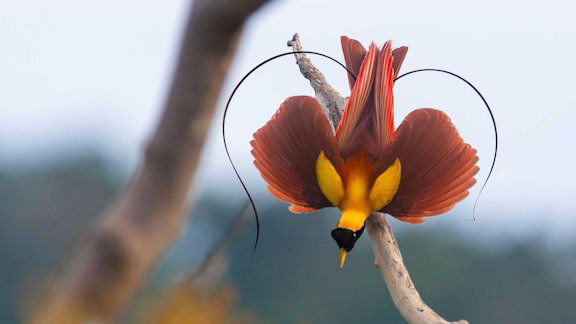(Photo: Red Bird-of-Paradise by Tim Laman)
Birds in the Paradisaeidae family—more than 40 species collectively called the birds-of-paradise—are famous for their spectacular mating dances. In the rainforests of New Guinea and Australia, male birds-of-paradise court mates with highly choreographed wing-flapping, tail-snapping displays, flaunting their dazzling colors in the process. Recently, scientists discovered a secret about these flashy birds that had been hiding in plain sight: birds-of-paradise have the ability to glow.
In a study published in February in the journal Royal Society Open Science, a team of researchers found that over 80% of birds-of-paradise species convert the sun’s invisible ultraviolet light into vivid yellows and greens. This process, known as biofluorescence, is made possible via specialized structures in the birds’ feathers, beaks, and skin that can absorb high-energy UV light and re-emit it at a lower energy level—making it visible to humans and other birds alike. The scientists believe the resulting glow helps birds accentuate their brilliant colors for mating displays.
Scientists have observed biofluorescence in a wide range of organisms including sharks, scorpions, and fungi. But outside of a few cases, little is known about the phenomenon in birds, says Rene Martin, an ichthyologist at the University of Nebraska–Lincoln and lead author of the study. While Martin specializes in the deep-sea fishes that glow in the ocean’s depths, she describes herself as fascinated by all types of organisms—and that curiosity led her to follow up on observations from fellow scientists about flashy birds.

The Red Bird-of-Paradise is colorful under regular lighting conditions, and some of its feathers glow a fluorescent yellow-green when illuminated by a blacklight. Photo by Rene Martin.
Scientists at the American Museum of Natural History had noticed that the birds-of-paradise specimens in the museum’s bird collection seemed to gleam. When Martin arrived at the museum as a postdoctoral researcher in 2023, she put the family under the spotlight—or rather, the blacklight.
After examining specimens from all birds-of-paradise species in the museum collection, Martin and her collaborators found that 37 species demonstrated biofluorescence somewhere on their bodies. The glowing patches occurred in a variety of plumages across the family, everywhere from the snowy white belly of a male King Bird-of-Paradise to the dark green mouth of the Carola’s Parotia, which blazed highlighter-yellow in ultraviolet light. And while this glow appears spectacular to human observers, it’s likely even more brilliant to the birds, which have specialized eyes that allow them to discern the biofluorescence in ways humans cannot.
In males, the biofluorescent regions overlapped with areas of the body that feature prominently in breeding displays; female birds-of-paradise also glowed, but the bright patches were much more diffuse. Martin concluded that males likely use their biofluorescence to further enhance their brilliant colors for mating, perhaps helping them pop in the low light of the dark rainforest understory. The function is less clear in females, although their mottled biofluorescent pattern may help them blend into dappled backgrounds.
For Edwin Scholes, the founder and director of the Cornell Lab of Ornithology’s Birds-of-Paradise Project, it’s no surprise that these stunning birds evolved ways to further enhance their plumage.
“Whenever we look into the evolution of ornamental traits in birds-of- paradise, they tend to be some of the most extreme that we know of—certainly in the bird world, but probably in the animal world as a whole,” says Scholes, who was not involved in the study. “As we dive a little deeper, we keep finding surprising things.”
“Just when people think, ‘Oh, we must know everything there is to know about birds-of-paradise,’ we find something completely mind-blowing,” Scholes says. “There’s still a lot to be discovered.”











